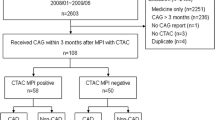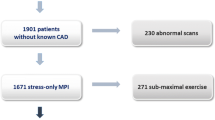Abstract
The aim of this study is the development of a database of normal women for quantitative analysis of exercise and reinjection myocardial single-photon emission computed tomography (SPET). We studied 101 subjects (40 males and 61 females) with less than 5% likelihood of coronary artery disease. All patients underwent stress and rest thallium-201 myocardial SPET. Myocardial stress was induced by bicycle exercise test (n=51), dipyridamole infusion (n=27) or a combined test (n=23). Multivariate ANOVA showed that the type of stress did not influence the percentage of thallium uptake for each region. Significant differences between men and women were found for the percentage of uptake in the inferior and the anterior wall. The most original finding of this study is the correlation between age and thallium uptake in the three regions of the anterior wall, showing an increase in measured thallium uptake with age for women. Consequently, two groups of women, those under and those over 55 years old, were separated, with a significantly lower tracer uptake in the anterior wall in the younger age group. These results may suggest that the commonly described breast tissue attenuation is due not only to breast volume or morphology but also to breast density. This emphasizes the need for two different databases for myocardial SPET quantitative analysis in the female population. Awareness of this fact should allow avoidance of any underestimation of possible anterior wall ischaemia in women aged more than 55 years.
Similar content being viewed by others

References
Depuey EG, Garcia EV. Optimal specificity of thallium-201 SPECT through recognition of imaging artifacts.J Nucl Med 1989; 30: 441–449.
Eisner RL, Tamas MJ, Cloninger K, Shonkoff D, Oates JA, Gober AM, Dunn DW, Malko JA, Churchwell AL, Patterson RE. Normal SPECT thallium-201 bull's-eye display: gender differences.J Nucl Med 1988; 29: 1901–1909.
Rabinovitch M, Suissa S, Elstein J. Sex-specific criteria for interpretation of thallium-201 myocardial uptake and washout studies.J Nucl Med 1986; 27: 1837–1841.
Cloninger KG, Eisner RL, Oates J, Noever T, Dunn D, Morris DC, Libermann HA, Churchwell AL, Patterson RE. Specificity of SPECT Tl-201 myocardial imaging in women: improvement by adjusting for breast attenuation [abstract].J Am Coll Cardiol 1987; 9: 140A.
Patterson RE, Eng C, Horowitz SF. Practical diagnosis of coronary artery disease: a Bayes' theorem nomogram to correlate clinical data with noninvasive exercise tests.Am J Cardiol 1984; 53: 252–256.
Diamond GA, Forrester JS. Analysis of probability as an aid in the clinical diagnosis of coronary artery disease.N Engl J Med 1979; 300: 1350–1357.
Levy M, Pornin M, Languillat N, Charles JP, Angelard T, Sarkis A, Bayet G, Guize L, Paillard M, Ourbak P. Tomoscintigraphie quantifiée au thallium. Interêt d'une injection intraveineuse de dipyridamole aprés une épreuve d'effort sous maximale négative.Arch Mal Coeur 1992; 85: 187–191.
Cottin Y, Touzery C, Toubeau M, Berriolo-Riedinger A, Morelon P, André F, Louis P, Wolf JE, Brunotte F. Scintigraphie myocardique au thallium 201: interêt de l'association dipyridamole effort pour améliorer le contraste des images.Med Nucl 1994; 18: 13–17.
Garcia EV, Van Train KF, Maddahi J, Prigent F, Friedman J, Areeda J, Waxman A, Berman DS. Quantification of rotational thallium-201 myocardial tomography.J Nucl Med 1985; 26: 17–26.
Touzery C, Morelon P, Andre F, Berriolo A, Riedinger JM, Toubeau M, Pelletier JL, Brunotte F. Animated 3-D model and quantification of left ventricle thallium scintigraphy.Eur J Nucl Med 1991; 18: 668.
Dilsizian V, Freedman MT, Bacharach SL, Perrone-Filardi P, Bonow RO. Regional thallium uptake in irreversible defects. Magnitude of change in thallium activity after reinjection distinguishes viable from nonviable myocardium.Circulation 1992; 85: 627–634.
Garcia EV, DePuey EG. Reversibility bull's-eye: a new polar map to quantify reversibility of stress induced SPECT T1-201 myocardial perfusion defects.J Nucl Med 1990; 31: 1240–1246.
DePasquale EE, Nody AC, De Puey EG. Quantitative rotational thallium-201 tomography for identifying and localizing coronary artery disease.Circulation 1988; 77: 316–327.
Lette J, Caron M, Cerino M, McNamara D, Metayer S, D'Aoust S, Eybalin M-C, Levesseur A, Gregoire J, Arsenault A. Normal qualitative and quantitative Tc-99m sestaMIBI myocardial SPECT: spectrum of intramyocardial distribution during exercise and at rest.Clin Nucl Med 1994; 19: 336–343.
Depasquale EE, Nody AC, Depuey EG, Garcia EV, Pilcher G, Bredlau C, Roubin G, Gober A, Gruentzig A, D'amato Paul, Berger HJ. Quantitative rotational thallium-201 tomography for identifying and localizing coronary artery disease.Circulation 1988; 77: 316–327.
Van Train FK, Areeda J, Garcia EV, Cooke D, Maddahi J, Kiat H, Germano G, Silagan G, Folks R, Berman DS. Quantitative same-day rest-stress technetium-99m-sestaMIBI SPECT: definition and validation of stress normal limits and criteria for abnormality.J Nucl Med 1993; 34: 1494–1502.
Van Train KF, Maddahi J, Berman DS, Kiat H, Areeda J, Prigent F, Friedman J. Quantitative analysis of tomographic stress thallium-201 myocardial scintigrams: a multicenter trial.J Nucl Med 1990; 31: 1168–1179.
Wolfe JN, Saftlas AF, Salane M. Mammographic parenchymal patterns and quantitative evaluation of mammographic densities: a case-control study.AJR 1987; 148: 1087–1092.
Basset LW, Ysrael M, Gold RH, Ysrael C. Usefulness of mammography and sonography in women less than 35 years of age.Radiology 1991; 180: 831–835.
Wolfe JN. Breast parenchymal patterns and their changes with age.Radiology 1976; 121: 545–552.
Kahn JK, McGhie I, Akers MS, Sill MN, Faber TL, Kulkarni PV, Willerson JT, Corbett JR. Quantitative rotational tomography with Tl-201 and Tc-99m 2-methoxy-isobutyl-isobutyl-isonitrile: a direct comparison in normal individuals and patients with coronary artery disease.Circulation 1989; 79: 1282–1293.
Author information
Authors and Affiliations
Rights and permissions
About this article
Cite this article
Cohen, M., Touzery, C., Cottin, Y. et al. Quantitative myocardial thallium single-photon emission computed tomography in normal women: Demonstration of age-related differences. Eur J Nucl Med 23, 25–30 (1996). https://doi.org/10.1007/BF01736986
Received:
Revised:
Issue Date:
DOI: https://doi.org/10.1007/BF01736986



